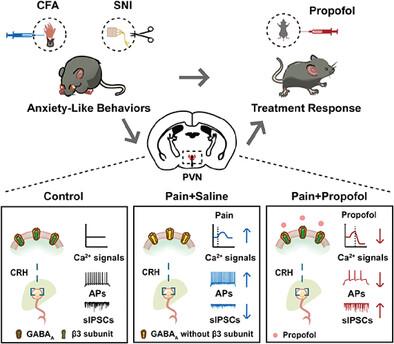Our official English website, www.x-mol.net, welcomes your
feedback! (Note: you will need to create a separate account there.)
Propofol Alleviates Anxiety-Like Behaviors Associated with Pain by Inhibiting the Hyperactivity of PVNCRH Neurons via GABAA Receptor β3 Subunits
Advanced Science ( IF 14.3 ) Pub Date : 2024-04-19 , DOI: 10.1002/advs.202309059 Le Yu 1, 2 , Xiaona Zhu 3 , Kang Peng 1, 2 , Huimin Qin 3 , Kexin Yang 3 , Fang Cai 3 , Ji Hu 3 , Ye Zhang 1, 2
Advanced Science ( IF 14.3 ) Pub Date : 2024-04-19 , DOI: 10.1002/advs.202309059 Le Yu 1, 2 , Xiaona Zhu 3 , Kang Peng 1, 2 , Huimin Qin 3 , Kexin Yang 3 , Fang Cai 3 , Ji Hu 3 , Ye Zhang 1, 2
Affiliation

|
Pain, a comorbidity of anxiety disorders, causes substantial clinical, social, and economic burdens. Emerging evidence suggests that propofol, the most commonly used general anesthetic, may regulate psychological disorders; however, its role in pain-associated anxiety is not yet described. This study investigates the therapeutic potential of a single dose of propofol (100 mg kg−1) in alleviating pain-associated anxiety and examines the underlying neural mechanisms. In acute and chronic pain models, propofol decreased anxiety-like behaviors in the elevated plus maze (EPM) and open field (OF) tests. Propofol also reduced the serum levels of stress-related hormones including corticosterone, corticotropin-releasing hormone (CRH), and norepinephrine. Fiber photometry recordings indicated that the calcium signaling activity of CRH neurons in the paraventricular nucleus (PVNCRH) is reduced after propofol treatment. Interestingly, artificially activating PVNCRH neurons through chemogenetics interfered with the anxiety-reducing effects of propofol. Electrophysiological recordings indicated that propofol decreases the activity of PVNCRH neurons by increasing spontaneous inhibitory postsynaptic currents (sIPSCs). Further, reducing the levels of γ-aminobutyric acid type A receptor β3 (GABAAβ3) subunits in PVNCRH neurons diminished the anxiety-relieving effects of propofol. In conclusion, this study provides a mechanistic and preclinical rationale to treat pain-associated anxiety-like behaviors using a single dose of propofol.
中文翻译:

异丙酚通过 GABAA 受体 β3 亚基抑制 PVNCRH 神经元的过度活跃,从而减轻与疼痛相关的焦虑样行为
疼痛是焦虑症的一种合并症,会造成巨大的临床、社会和经济负担。新的证据表明,最常用的全身麻醉剂异丙酚可以调节心理障碍。然而,其在疼痛相关焦虑中的作用尚未得到描述。本研究探讨了单剂量异丙酚(100 mg kg -1 )在缓解疼痛相关焦虑方面的治疗潜力,并检查了潜在的神经机制。在急性和慢性疼痛模型中,异丙酚可减少高架十字迷宫(EPM)和开放场(OF)测试中的焦虑样行为。异丙酚还降低了与压力相关的激素的血清水平,包括皮质酮、促肾上腺皮质激素释放激素(CRH)和去甲肾上腺素。纤维光度测定记录表明,异丙酚治疗后室旁核 (PVN CRH ) 中 CRH 神经元的钙信号活性降低。有趣的是,通过化学遗传学人工激活 PVN CRH神经元会干扰异丙酚的减轻焦虑作用。电生理记录表明,异丙酚通过增加自发抑制性突触后电流 (sIPSC) 来降低 PVN CRH神经元的活性。此外,降低 PVN CRH神经元中γ-氨基丁酸 A 型受体β 3 (GABA A β 3) 亚基的水平会减弱异丙酚的缓解焦虑作用。总之,这项研究提供了使用单剂量异丙酚治疗与疼痛相关的焦虑样行为的机制和临床前原理。
更新日期:2024-04-19
中文翻译:

异丙酚通过 GABAA 受体 β3 亚基抑制 PVNCRH 神经元的过度活跃,从而减轻与疼痛相关的焦虑样行为
疼痛是焦虑症的一种合并症,会造成巨大的临床、社会和经济负担。新的证据表明,最常用的全身麻醉剂异丙酚可以调节心理障碍。然而,其在疼痛相关焦虑中的作用尚未得到描述。本研究探讨了单剂量异丙酚(100 mg kg -1 )在缓解疼痛相关焦虑方面的治疗潜力,并检查了潜在的神经机制。在急性和慢性疼痛模型中,异丙酚可减少高架十字迷宫(EPM)和开放场(OF)测试中的焦虑样行为。异丙酚还降低了与压力相关的激素的血清水平,包括皮质酮、促肾上腺皮质激素释放激素(CRH)和去甲肾上腺素。纤维光度测定记录表明,异丙酚治疗后室旁核 (PVN CRH ) 中 CRH 神经元的钙信号活性降低。有趣的是,通过化学遗传学人工激活 PVN CRH神经元会干扰异丙酚的减轻焦虑作用。电生理记录表明,异丙酚通过增加自发抑制性突触后电流 (sIPSC) 来降低 PVN CRH神经元的活性。此外,降低 PVN CRH神经元中γ-氨基丁酸 A 型受体β 3 (GABA A β 3) 亚基的水平会减弱异丙酚的缓解焦虑作用。总之,这项研究提供了使用单剂量异丙酚治疗与疼痛相关的焦虑样行为的机制和临床前原理。


















































 京公网安备 11010802027423号
京公网安备 11010802027423号